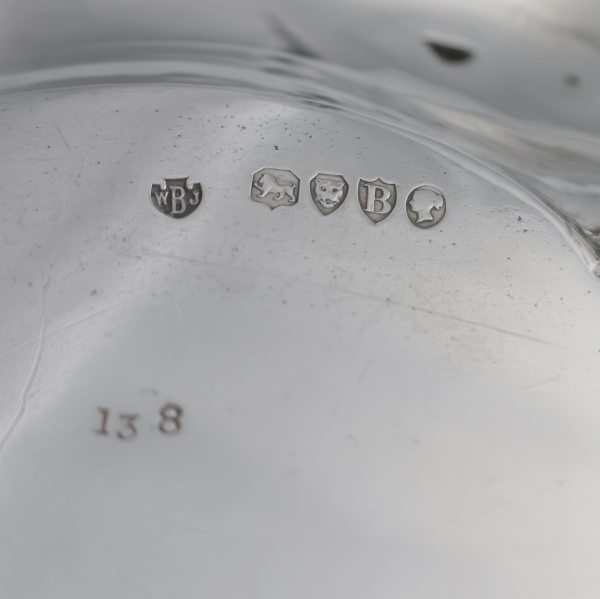A Victorian sterling silver hunting presentation coffee service, Edward Barnard & Sons, London, 1876
John Grimes Harvey Esq was a prominent figure in hunting circles. His family were gentlemen farmers on the Isle of Wight and in 1845 his father and other friends created the Isle of milk jug, half pint cream jug, horn, spirit flask (signed by Prince Henry of Battenburg), cigarette case etc’.
Father and son both held the office of Mastership of the ISW Hunt, carrying the horn for many seasons. John Grimes Harvey was considered a good sportsman and fine horseman and in 1888 he was offered the appointment of Royal Huntsman to Her Majesty’s Staghounds known as the Royal Buckhounds based at Ascot. He retired in 1897 and spent his remaining years back on the Isle of Wight.an and a very fine horseman, was offered the appointment of huntsman to Her Majesty’s Staghounds, which he accepted.
A Victorian silver Hunting presentation coffee service, comprising:
a Victorian silver coffee pot,
by Edward Barnard & Sons, London 1876,
of vase shape with beaded rims and acanthus borders, also chased and engraved with swags of flowers and putto masks tied with ribbons, on pedestal circular feet, with leaf capped bifurcated scroll handles, monogrammed within beaded oval cartouches,
the coffee pot with waisted domed cover and finial modelled as a hound,
a Victorian salver,
by Walter & John Barnard, London 1877,
of shaped circular form on four pierced leaf and scroll feet, the border with alternating cast masks with trailing foliage in between with engraved trellis work below, the centre with presentation inscription* and monogrammed, surrounded by foliate engraved swags,
*The inscription reads as follows:
Presented to John Grimes Harvey Esq.
By the Members of the Hunt and Other Friends
On his resigning the Mastership of the
Isle of Wight Hounds
As a Recognition of His untiring zeal and energy
In showing sport during
His Mastership
1878.
THE FLASK THAT SAVED A PRINCE
Sworders' Silver & Jewellery sale on 24 November brings an intriguing tale of a huntsman rewarded for saving the life of a Prince.
Quite what happened when Queen Victoria’s son-in-law, Prince Henry of Battenberg, went hunting in January 1886 is not clear, but the clue is in the large dent in the inscribed silver spirit flask he later presented to John Grimes Harvey Esq. of the Isle of Wight Hunt as a token of gratitude.
Family tradition has it that Harvey, who was acting as gentleman huntsman in an honorary position under General Sir Henry Daly, the Master of the Hunt at that time, was instrumental in rescuing the prince after a heavy blow from a horse’s hoof, which caused the dent in the flask.
Harvey was a prominent figure in hunting circles. His family were gentlemen farmers on the Isle of Wight and in 1845 his father and other friends created the Isle of Wight Foxhounds. Father and son both held the office of Mastership of the IoW Hunt, carrying the horn for many seasons.
John Grimes Harvey was considered a good sportsman and fine horseman and in 1888 he was offered the appointment of Royal Huntsman to Her Majesty’s Staghounds, known as the Royal Buckhounds, based at Ascot – supposedly as another grateful gesture for his rescue of the prince, who was married to the Queen’s youngest daughter, Princess Beatrice, and later became Governor of the Isle of Wight.
Harvey retired in 1897 and spent his remaining years back on the Isle of Wight.
Sterling Silver with 5 Hallmarks:
Duty mark: Head Queen Victoria
Cofee pot
HxLxD 6,69in x 11,42in x 11,42in
Salver
HxLxD 2,17cm x 18,70cm x 18,70cm
Coffee pot: 23,14oz
Salver: 92,63oz
Private collection
Slight signs of age and superficial scratches. The five hallmarks are located below the handle of the coffee pot. The five hallmarks are located at the base of the salver
Since we are not professional conservators or restorers, we urge you to consult with a restorer or conservator of your choice who will be better able to provide a detailed, professional report. Prospective buyers must understand that any statement made by Coradi Rare Finds is merely a subjective opinion.
Edward Barnard and Sons was a distinguished British silversmithing firm with a history spanning over three centuries. Its origins trace back to circa 1680, when silversmith Anthony Nelme established a workshop in Ave Maria Lane, London. Following Nelme's death in 1722, the business was inherited by his son, Francis Nelme. In 1786, the Barnard family became involved when Henry Chawner, a former master to Edward Barnard I, took over the firm. Edward Barnard I became the manager, and upon Chawner's retirement, he assumed ownership in 1829, trading as Edward Barnard & Sons alongside his sons: Edward Barnard II, John Barnard, and William Barnard.
The firm is renowned for creating the Lily font, a large silver gilt baptismal font commissioned by Queen Victoria for the christening of her first child, Victoria, Princess Royal, on February 10, 1840.
Over the years, Edward Barnard and Sons operated from various locations in London, including Angel Street, Fetter Lane, and Hatton Garden. In 1977, the company became a subsidiary of Padgett & Braham and ceased operations in 2003.
Regarding hallmarks, Edward Barnard and Sons utilized specific maker's marks to identify their silver pieces. These marks typically included the firm's name or initials, such as "E B & S LD" or "E B S L D," along with the lion passant (indicating sterling silver), the city mark for London, and the date letter corresponding to the year of manufacture.








